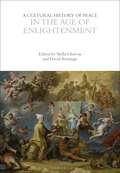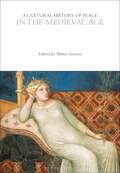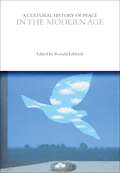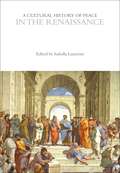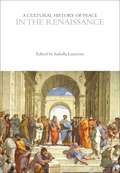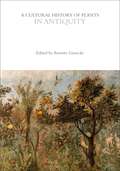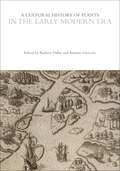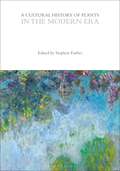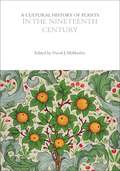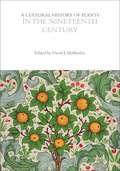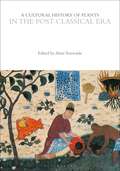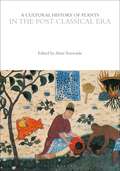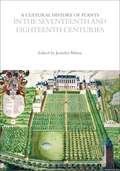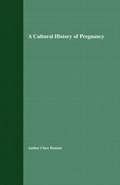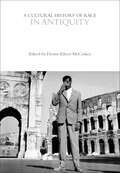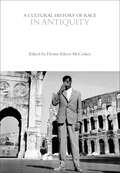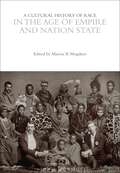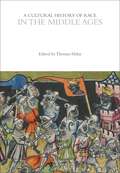- Table View
- List View
A Cultural History of Peace in the Age of Enlightenment (The Cultural Histories Series)
by Stella Ghervas and David ArmitageA Cultural History of Peace presents an authoritative survey from ancient times to the present. The set of six volumes covers over 2500 years of history, charting the evolving nature and role of peace throughout history.This volume, A Cultural History of Peace in the Enlightenment, explores peace in the period from 1648 to 1815. As with all the volumes in the illustrated Cultural History of Peace set, this volume presents essays on the meaning of peace, peace movements, maintaining peace, peace in relation to gender, religion and war and representations of peace.A Cultural History of Peace in the Enlightenment is the most authoritative and comprehensive survey available on peace in the long eighteenth century.
A Cultural History of Peace in the Medieval Age (The Cultural Histories Series)
by Walter SimonsA Cultural History of Peace presents an authoritative survey from ancient times to the present. The set of six volumes covers over 2500 years of history, charting the evolving nature and role of peace throughout history.This volume, A Cultural History of Peace in the Medieval Age explores peace from 800 to 1450. As with all the volumes in the illustrated Cultural History of Peace set, this volume presents essays on the meaning of peace, peace movements, maintaining peace, peace in relation to gender, religion and war and representations of peace.A Cultural History of Peace in the Medieval Age is the most authoritative and comprehensive survey available on peace in the medieval era.
A Cultural History of Peace in the Medieval Age (The Cultural Histories Series)
A Cultural History of Peace presents an authoritative survey from ancient times to the present. The set of six volumes covers over 2500 years of history, charting the evolving nature and role of peace throughout history.This volume, A Cultural History of Peace in the Medieval Age explores peace from 800 to 1450. As with all the volumes in the illustrated Cultural History of Peace set, this volume presents essays on the meaning of peace, peace movements, maintaining peace, peace in relation to gender, religion and war and representations of peace.A Cultural History of Peace in the Medieval Age is the most authoritative and comprehensive survey available on peace in the medieval era.
A Cultural History of Peace in the Modern Age (The Cultural Histories Series)
by Ronald EdsforthA Cultural History of Peace presents an authoritative survey from ancient times to the present. The set of six volumes covers over 2500 years of history, charting the evolving nature and role of peace throughout history.This volume, A Cultural History of Peace in the Modern Age, explores peace in the period from 1920 to the present. As with all the volumes in the illustrated Cultural History of Peace set, this volume presents essays on the meaning of peace, peace movements, maintaining peace, peace in relation to gender, religion and war and representations of peace.A Cultural History of Peace in the Modern Age is the most authoritative and comprehensive survey available on peace in the twentieth and twentieth century.
A Cultural History of Peace in the Modern Age (The Cultural Histories Series)
A Cultural History of Peace presents an authoritative survey from ancient times to the present. The set of six volumes covers over 2500 years of history, charting the evolving nature and role of peace throughout history.This volume, A Cultural History of Peace in the Modern Age, explores peace in the period from 1920 to the present. As with all the volumes in the illustrated Cultural History of Peace set, this volume presents essays on the meaning of peace, peace movements, maintaining peace, peace in relation to gender, religion and war and representations of peace.A Cultural History of Peace in the Modern Age is the most authoritative and comprehensive survey available on peace in the twentieth and twentieth century.
A Cultural History of Peace in the Renaissance (The Cultural Histories Series)
by Isabella LazzariniA Cultural History of Peace presents an authoritative survey from ancient times to the present. The set of six volumes covers over 2500 years of history, charting the evolving nature and role of peace throughout history.This volume, A Cultural History of Peace in the Renaissance, explores peace in the period from 1450 to 1648. As with all the volumes in the illustrated Cultural History of Peace set, this volume presents essays on the meaning of peace, peace movements, maintaining peace, peace in relation to gender, religion and war and representations of peace.A Cultural History of Peace in the Renaissance is the most authoritative and comprehensive survey available on peace in the early modern era.
A Cultural History of Peace in the Renaissance (The Cultural Histories Series)
A Cultural History of Peace presents an authoritative survey from ancient times to the present. The set of six volumes covers over 2500 years of history, charting the evolving nature and role of peace throughout history.This volume, A Cultural History of Peace in the Renaissance, explores peace in the period from 1450 to 1648. As with all the volumes in the illustrated Cultural History of Peace set, this volume presents essays on the meaning of peace, peace movements, maintaining peace, peace in relation to gender, religion and war and representations of peace.A Cultural History of Peace in the Renaissance is the most authoritative and comprehensive survey available on peace in the early modern era.
A Cultural History of Plants in Antiquity (The Cultural Histories Series)
by Annette GieseckeA Cultural History of Plants in Antiquity covers the period from 10,000 BCE to 500 CE. This period witnessed the transition from hunter-gatherer subsistence to the practice of agriculture in Mesopotamia and elsewhere, and culminated in the fall of the Roman Empire, the end of the Han Dynasty in China, the rise of Byzantium, and the first flowering of Mayan civilization. Human uses for and understanding of plants drove cultural evolution and were inextricably bound to all aspects of cultural practice. The growth of botanical knowledge was fundamental to the development of agriculture, technology, medicine, and science, as well as to the birth of cities, the rise of religions and mythologies, and the creation of works of literature and art. The 6 volume set of the Cultural History of Plants presents the first comprehensive history of the uses and meanings of plants from prehistory to today. The themes covered in each volume are plants as staple foods; plants as luxury foods; trade and exploration; plant technology and science; plants and medicine; plants in culture; plants as natural ornaments; the representation of plants. Annette Giesecke is Professor of Classics at the University of Delaware, USA. Volume 1 in the Cultural History of Plants set.General Editors: Annette Giesecke, University of Delaware, USA, and David Mabberley, University of Oxford, UK.
A Cultural History of Plants in Antiquity (The Cultural Histories Series)
A Cultural History of Plants in Antiquity covers the period from 10,000 BCE to 500 CE. This period witnessed the transition from hunter-gatherer subsistence to the practice of agriculture in Mesopotamia and elsewhere, and culminated in the fall of the Roman Empire, the end of the Han Dynasty in China, the rise of Byzantium, and the first flowering of Mayan civilization. Human uses for and understanding of plants drove cultural evolution and were inextricably bound to all aspects of cultural practice. The growth of botanical knowledge was fundamental to the development of agriculture, technology, medicine, and science, as well as to the birth of cities, the rise of religions and mythologies, and the creation of works of literature and art. The 6 volume set of the Cultural History of Plants presents the first comprehensive history of the uses and meanings of plants from prehistory to today. The themes covered in each volume are plants as staple foods; plants as luxury foods; trade and exploration; plant technology and science; plants and medicine; plants in culture; plants as natural ornaments; the representation of plants. Annette Giesecke is Professor of Classics at the University of Delaware, USA. Volume 1 in the Cultural History of Plants set.General Editors: Annette Giesecke, University of Delaware, USA, and David Mabberley, University of Oxford, UK.
A Cultural History of Plants in the Early Modern Era (The Cultural Histories Series)
by Andrew Dalby and Annette GieseckeA Cultural History of Plants in the Early Modern Era covers the period from 1400 to 1650, a time of discovery and rediscovery, of experiment and innovation. Renaissance learning brought ancient knowledge to modern European consciousness whilst exploration placed all the continents in contact with one another. The dissemination of knowledge was further speeded by the spread of printing. New staples and spices, new botanical medicines, and new garden plants all catalysed agriculture, trade, and science. The great medical botanists of the period attempted no less than what Marlowe's Dr Faustus demanded - a book “wherein I might see all plants, herbs, and trees that grow upon the earth.” Human impact on plants and our botanical knowledge had irrevocably changed. The 6 volume set of the Cultural History of Plants presents the first comprehensive history of the uses and meanings of plants from prehistory to today. The themes covered in each volume are plants as staple foods; plants as luxury foods; trade and exploration; plant technology and science; plants and medicine; plants in culture; plants as natural ornaments; the representation of plants. Andrew Dalby is an independent scholar and writer, based in France. Annette Giesecke is Professor of Classics at the University of Delaware, USA. Volume 3 in the Cultural History of Plants set.General Editors: Annette Giesecke, University of Delaware, USA, and David Mabberley, University of Oxford, UK.
A Cultural History of Plants in the Early Modern Era (The Cultural Histories Series)
A Cultural History of Plants in the Early Modern Era covers the period from 1400 to 1650, a time of discovery and rediscovery, of experiment and innovation. Renaissance learning brought ancient knowledge to modern European consciousness whilst exploration placed all the continents in contact with one another. The dissemination of knowledge was further speeded by the spread of printing. New staples and spices, new botanical medicines, and new garden plants all catalysed agriculture, trade, and science. The great medical botanists of the period attempted no less than what Marlowe's Dr Faustus demanded - a book “wherein I might see all plants, herbs, and trees that grow upon the earth.” Human impact on plants and our botanical knowledge had irrevocably changed. The 6 volume set of the Cultural History of Plants presents the first comprehensive history of the uses and meanings of plants from prehistory to today. The themes covered in each volume are plants as staple foods; plants as luxury foods; trade and exploration; plant technology and science; plants and medicine; plants in culture; plants as natural ornaments; the representation of plants. Andrew Dalby is an independent scholar and writer, based in France. Annette Giesecke is Professor of Classics at the University of Delaware, USA. Volume 3 in the Cultural History of Plants set.General Editors: Annette Giesecke, University of Delaware, USA, and David Mabberley, University of Oxford, UK.
A Cultural History of Plants in the Modern Era (The Cultural Histories Series)
by Stephen ForbesA Cultural History of Plants in the Modern Era covers the period from 1920 to today - a time when population growth, industrialization, global trade, and consumerism have fundamentally reshaped our relationship with plants. Advances in agriculture, science, and technology have revolutionised the ways we feed ourselves, whilst urbanization and industrial processing have reduced our direct connection with living plants. At the same time, our understanding of both ecology and conservation have greatly increased and our appreciation of the meanings and aesthetics of plants continue to suffuse art and everyday culture. The modern era has witnessed a revolution in both the valuation and the destruction of the natural world - more than ever before, we understand that the vitality of our relationship with plants will shape our future. The 6 volume set of the Cultural History of Plants presents the first comprehensive history of the uses and meanings of plants from prehistory to today. The themes covered in each volume are plants as staple foods; plants as luxury foods; trade and exploration; plant technology and science; plants and medicine; plants in culture; plants as natural ornaments; the representation of plants.Stephen Forbes is an independent scholar and writer, based in Australia. Volume 6 in the Cultural History of Plants set.General Editors: Annette Giesecke, University of Delaware, USA, and David Mabberley, University of Oxford, UK.
A Cultural History of Plants in the Modern Era (The Cultural Histories Series)
A Cultural History of Plants in the Modern Era covers the period from 1920 to today - a time when population growth, industrialization, global trade, and consumerism have fundamentally reshaped our relationship with plants. Advances in agriculture, science, and technology have revolutionised the ways we feed ourselves, whilst urbanization and industrial processing have reduced our direct connection with living plants. At the same time, our understanding of both ecology and conservation have greatly increased and our appreciation of the meanings and aesthetics of plants continue to suffuse art and everyday culture. The modern era has witnessed a revolution in both the valuation and the destruction of the natural world - more than ever before, we understand that the vitality of our relationship with plants will shape our future. The 6 volume set of the Cultural History of Plants presents the first comprehensive history of the uses and meanings of plants from prehistory to today. The themes covered in each volume are plants as staple foods; plants as luxury foods; trade and exploration; plant technology and science; plants and medicine; plants in culture; plants as natural ornaments; the representation of plants.Stephen Forbes is an independent scholar and writer, based in Australia. Volume 6 in the Cultural History of Plants set.General Editors: Annette Giesecke, University of Delaware, USA, and David Mabberley, University of Oxford, UK.
A Cultural History of Plants in the Nineteenth Century (The Cultural Histories Series)
by David J. MabberleyA Cultural History of Plants in the Nineteenth Century covers the period from 1800 to 1920, a time of astonishing growth in industrialization, urbanization, migration, population growth, colonial possessions, and developments in scientific knowledge. As European modes of civilization and cultivation were exported worldwide, botanical study was revolutionized – through the work of Charles Darwin and many others – and the new science of biology was born, based on cells, nuclei and molecules. As Darwinism took hold, plants came to be seen as a way of thinking about the connectivity of nature and life itself. The 6 volume set of the Cultural History of Plants presents the first comprehensive history of the uses and meanings of plants from prehistory to today. The themes covered in each volume are plants as staple foods; plants as luxury foods; trade and exploration; plant technology and science; plants and medicine; plants in culture; plants as natural ornaments; the representation of plants. David Mabberley is Emeritus Fellow at Wadham College, University of Oxford, UK; Emeritus Professor at the University of Leiden, The Netherlands; and Adjunct Professor at Macquarie University, Australia. Volume 5 in the Cultural History of Plants set.General Editors: Annette Giesecke, University of Delaware, USA, and David Mabberley, University of Oxford, UK.
A Cultural History of Plants in the Nineteenth Century (The Cultural Histories Series)
A Cultural History of Plants in the Nineteenth Century covers the period from 1800 to 1920, a time of astonishing growth in industrialization, urbanization, migration, population growth, colonial possessions, and developments in scientific knowledge. As European modes of civilization and cultivation were exported worldwide, botanical study was revolutionized – through the work of Charles Darwin and many others – and the new science of biology was born, based on cells, nuclei and molecules. As Darwinism took hold, plants came to be seen as a way of thinking about the connectivity of nature and life itself. The 6 volume set of the Cultural History of Plants presents the first comprehensive history of the uses and meanings of plants from prehistory to today. The themes covered in each volume are plants as staple foods; plants as luxury foods; trade and exploration; plant technology and science; plants and medicine; plants in culture; plants as natural ornaments; the representation of plants. David Mabberley is Emeritus Fellow at Wadham College, University of Oxford, UK; Emeritus Professor at the University of Leiden, The Netherlands; and Adjunct Professor at Macquarie University, Australia. Volume 5 in the Cultural History of Plants set.General Editors: Annette Giesecke, University of Delaware, USA, and David Mabberley, University of Oxford, UK.
A Cultural History of Plants in the Post-Classical Era (The Cultural Histories Series)
by Alain TouwaideA Cultural History of Plants in the Post-Classical Era covers the period from 500 to 1400, ranging across northern and central Europe to the Mediterranean, and from the Byzantine and Arabic Empires to the Persian World, India, and China. This was an age of empires and fluctuating borders, presenting a changing mosaic of environments, populations, and cultural practices. Many of the ancient uses and meanings of plants were preserved, but these were overlaid with new developments in agriculture, landscapes, medicine, eating habits, and art. The 6 volume set of the Cultural History of Plants presents the first comprehensive history of the uses and meanings of plants from prehistory to today. The themes covered in each volume are plants as staple foods; plants as luxury foods; trade and exploration; plant technology and science; plants and medicine; plants in culture; plants as natural ornaments; the representation of plants. Alain Touwaide is Scientific Director at the Institute for the Preservation of Medical Traditions, Washington, D.C., USA. Volume 2 in the Cultural History of Plants set.General Editors: Annette Giesecke, University of Delaware, USA, and David Mabberley, University of Oxford, UK.
A Cultural History of Plants in the Post-Classical Era (The Cultural Histories Series)
A Cultural History of Plants in the Post-Classical Era covers the period from 500 to 1400, ranging across northern and central Europe to the Mediterranean, and from the Byzantine and Arabic Empires to the Persian World, India, and China. This was an age of empires and fluctuating borders, presenting a changing mosaic of environments, populations, and cultural practices. Many of the ancient uses and meanings of plants were preserved, but these were overlaid with new developments in agriculture, landscapes, medicine, eating habits, and art.The six-volume set of the Cultural History of Plants presents the first comprehensive history of the uses and meanings of plants from prehistory to today. The themes covered in each volume are plants as staple foods; plants as luxury foods; trade and exploration; plant technology and science; plants and medicine; plants in culture; plants as natural ornaments; the representation of plants.Alain Touwaide is Scientific Director at the Institute for the Preservation of Medical Traditions, Washington, D.C., USA.A Cultural History of Plants in the Post-Classical Era is the second volume in the six-volume set, A Cultural History of Plants, also available online as part of Bloomsbury Cultural History, a fully-searchable digital library (see www.bloomsburyculturalhistory.com).General Editors: Annette Giesecke, University of Delaware, USA, and David Mabberley, University of Oxford, UK.
A Cultural History of Plants in the Seventeenth and Eighteenth Centuries (The Cultural Histories Series)
by Jennifer MilamA Cultural History of Plants in the Seventeenth and Eighteenth Centuries covers the period from 1650 to 1800,a time of global exploration and the discovery of new species of plants and their potential uses. Trade routes were established which brought Europeans into direct contact with the plants and people of Asia, Oceania, Africa and the Americas. Foreign and exotic plants become objects of cultivation, collection, and display, whilst the applications of plants became central not only to naturalists, landowners, and gardeners but also to philosophers, artists, merchants, scientists, and rulers. As the Enlightenment took hold, the natural world became something to be grasped through reasoned understanding. The 6 volume set of the Cultural History of Plants presents the first comprehensive history of the uses and meanings of plants from prehistory to today. The themes covered in each volume are plants as staple foods; plants as luxury foods; trade and exploration; plant technology and science; plants and medicine; plants in culture; plants as natural ornaments; the representation of plants. Jennifer Milam is Pro Vice-Chancellor and Professor of Art History, University of Newcastle, Australia. Volume 4 in the Cultural History of Plants set.General Editors: Annette Giesecke, University of Delaware, USA, and David Mabberley, University of Oxford, UK.
A Cultural History of Plants in the Seventeenth and Eighteenth Centuries (The Cultural Histories Series)
A Cultural History of Plants in the Seventeenth and Eighteenth Centuries covers the period from 1650 to 1800,a time of global exploration and the discovery of new species of plants and their potential uses. Trade routes were established which brought Europeans into direct contact with the plants and people of Asia, Oceania, Africa and the Americas. Foreign and exotic plants become objects of cultivation, collection, and display, whilst the applications of plants became central not only to naturalists, landowners, and gardeners but also to philosophers, artists, merchants, scientists, and rulers. As the Enlightenment took hold, the natural world became something to be grasped through reasoned understanding. The 6 volume set of the Cultural History of Plants presents the first comprehensive history of the uses and meanings of plants from prehistory to today. The themes covered in each volume are plants as staple foods; plants as luxury foods; trade and exploration; plant technology and science; plants and medicine; plants in culture; plants as natural ornaments; the representation of plants. Jennifer Milam is Pro Vice-Chancellor and Professor of Art History, University of Newcastle, Australia. Volume 4 in the Cultural History of Plants set.General Editors: Annette Giesecke, University of Delaware, USA, and David Mabberley, University of Oxford, UK.
A Cultural History of Pregnancy: Pregnancy, Medicine and Culture, 1750-2000
by C. HansonHanson explores the different ways in which pregnancy has been constructed and interpreted in Britain over the last 250 years. Drawing on a wide range of sources, including obstetric texts, pregnancy advice books, literary texts, popular fiction and visual images, she analyzes changing attitudes to key issues such as the relative rights of mother and foetus and the degree to which medical intervention is acceptable in pregnancy. Hanson also considers the effects of medical and social changes on the subjective experience of pregnancy.
A Cultural History of Race in Antiquity (The Cultural Histories Series)
by Denise Eileen McCoskeyThe era generally referred to as antiquity lasted for thousands of years and was characterized by a diverse range of peoples and cultural systems. This volume explores some of the specific ways race was defined and mobilized by different groups-including the Greeks, Romans, Egyptians, Persians, and Ethiopians- as they came into contact with one another during this period. Key to this inquiry is the examination of institutions, such as religion and politics, and forms of knowledge, such as science, that circumscribed the formation of ancient racial identities and helped determine their meanings and consequences. Drawing on a range of ancient evidence-literature, historical writing, documentary evidence, and ancient art and archaeology-this volume highlights both the complexity of ancient racial ideas and the often violent and asymmetrical power structures embedded in ancient racial representations and practices like war and the enslavement of other persons. The study of race in antiquity has long been clouded by modern assumptions, so this volume also seeks to outline a better method for apprehending race on its own terms in the ancient world, including its relationship to other forms of identity, such as ethnicity and gender, while also seeking to identify and debunk some of the racist methods and biases that have been promulgated by classical historians themselves over the last few centuries.
A Cultural History of Race in Antiquity (The Cultural Histories Series)
The era generally referred to as antiquity lasted for thousands of years and was characterized by a diverse range of peoples and cultural systems. This volume explores some of the specific ways race was defined and mobilized by different groups-including the Greeks, Romans, Egyptians, Persians, and Ethiopians- as they came into contact with one another during this period. Key to this inquiry is the examination of institutions, such as religion and politics, and forms of knowledge, such as science, that circumscribed the formation of ancient racial identities and helped determine their meanings and consequences. Drawing on a range of ancient evidence-literature, historical writing, documentary evidence, and ancient art and archaeology-this volume highlights both the complexity of ancient racial ideas and the often violent and asymmetrical power structures embedded in ancient racial representations and practices like war and the enslavement of other persons. The study of race in antiquity has long been clouded by modern assumptions, so this volume also seeks to outline a better method for apprehending race on its own terms in the ancient world, including its relationship to other forms of identity, such as ethnicity and gender, while also seeking to identify and debunk some of the racist methods and biases that have been promulgated by classical historians themselves over the last few centuries.
A Cultural History of Race in the Age of Empire and Nation State (The Cultural Histories Series)
by Marina B. MogilnerThis volume covers the cultural history of race in 'the long 19th century' – the age of empire and nation-state, a transformative period during which a modern world had been forged and complex and hierarchical imperial formations were challenged by the emerging national norm. The concept of race emerged as a dominant epistemology in the context of the conflicting entanglement of empire and nation as two alternative but quite compatible forms of social imaginary. It penetrated all spheres of life under the novel conditions of the emerging mass culture and mass society and with the sanction of anthropocentric and positivistic science. Allegedly primeval and parasocial, 'race' was seen as a uniquely stable constant in a society in flux amid transforming institutions, economies, and political regimes. But contrary to this perception, there was nothing stable or natural about 'race.' The spread of racializing social and political imagination only reinforced the need for constant renegotiation and readjustment of racial boundaries. Therefore, avoiding any structuralist simplifications, this volume looks at specific imperial, nationalizing, and hybrid contexts framing the semantics and politics of race in the course of the long 19th century. In different parts of the globalizing world, various actors were applying their own notions of 'race' to others and to themselves, embracing it simultaneously as a language of othering and personal subjectivity. Consequently, the cultural history of race as told in this volume unfolds on many levels, in multiple loci, and in different genres, thus reflecting the qualities of race as an omnipresent and all-embracing discourse of the time
A Cultural History of Race in the Age of Empire and Nation State (The Cultural Histories Series)
This volume covers the cultural history of race in 'the long 19th century' – the age of empire and nation-state, a transformative period during which a modern world had been forged and complex and hierarchical imperial formations were challenged by the emerging national norm. The concept of race emerged as a dominant epistemology in the context of the conflicting entanglement of empire and nation as two alternative but quite compatible forms of social imaginary. It penetrated all spheres of life under the novel conditions of the emerging mass culture and mass society and with the sanction of anthropocentric and positivistic science. Allegedly primeval and parasocial, 'race' was seen as a uniquely stable constant in a society in flux amid transforming institutions, economies, and political regimes. But contrary to this perception, there was nothing stable or natural about 'race.' The spread of racializing social and political imagination only reinforced the need for constant renegotiation and readjustment of racial boundaries. Therefore, avoiding any structuralist simplifications, this volume looks at specific imperial, nationalizing, and hybrid contexts framing the semantics and politics of race in the course of the long 19th century. In different parts of the globalizing world, various actors were applying their own notions of 'race' to others and to themselves, embracing it simultaneously as a language of othering and personal subjectivity. Consequently, the cultural history of race as told in this volume unfolds on many levels, in multiple loci, and in different genres, thus reflecting the qualities of race as an omnipresent and all-embracing discourse of the time
A Cultural History of Race in the Middle Ages (The Cultural Histories Series)
by Thomas HahnThis volume presents a comprehensive and collaborative survey of how people, individually and within collective entities, thought about, experienced, and enacted racializing differences. Addressing events, texts, and images from the 5th to the 16th centuries, these essays by ten eminent scholars provide broad, multi-disciplinary analyses of materials whose origins range from the British Isles, Western Iberia, and North Africa across Western and Eastern Europe to the Middle East. These diverse communities possessed no single word equivalent to modern race, a term (raza) for genetic, religious, cultural, or territorial difference that emerges only at the end of the medieval period. Chapter by chapter, this volume nonetheless demonstrates the manifold beliefs, practices, institutions, and images that conveyed and enforced difference for the benefit of particular groups and to the detriment of others. Addressing the varying historiographical self-consciousness concerning race among medievalist scholars themselves, the separate analyses make use of paradigms drawn from social and political history, religious, environmental, literary, ethnic, and gender studies, the history of art and of science, and critical race theory. Chapters identify the eruption of racial discourses aroused by political or religious polemic, centered upon conversion within and among Jewish, Christian, and Islamic communions, and inspired by imagined or sustained contact with alien peoples. Authors draw their evidence from Hebrew, Latin, Arabic, and a profusion of European vernaculars, and provide searching examinations of visual artefacts ranging from religious service books to maps, mosaics, and manuscript illuminations
